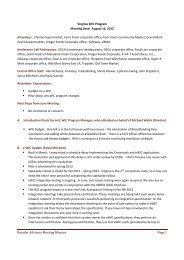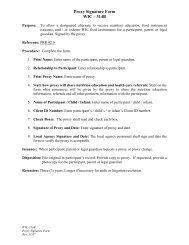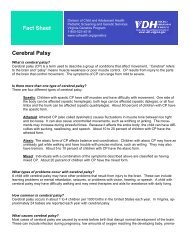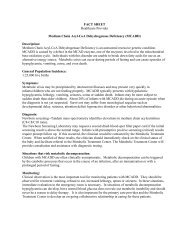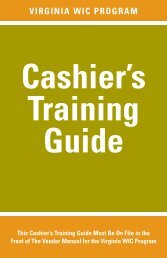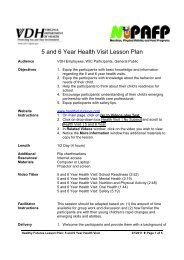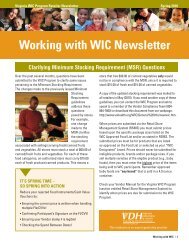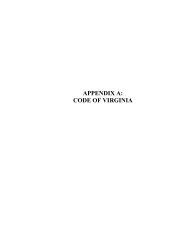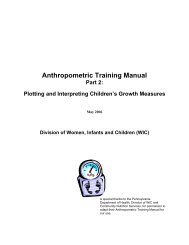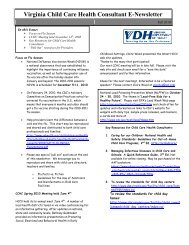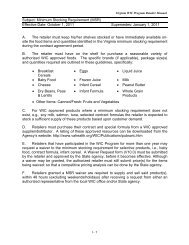WIC EBT Feasibility Study and Cost‐Benefit Analysis
WIC EBT Feasibility Study and Cost‐Benefit Analysis
WIC EBT Feasibility Study and Cost‐Benefit Analysis
You also want an ePaper? Increase the reach of your titles
YUMPU automatically turns print PDFs into web optimized ePapers that Google loves.
Virginia Department of Health <strong>WIC</strong> <strong>EBT</strong> <strong>Feasibility</strong> <strong>Study</strong> <strong>and</strong> Cost-Benefit <strong>Analysis</strong><br />
1. GENERAL INFORMATION<br />
The Special Supplemental Nutrition Program for Women, Infants <strong>and</strong> Children (<strong>WIC</strong>) is<br />
designed to provide nutritious foods, nutrition education, <strong>and</strong> referrals to health <strong>and</strong> other social<br />
services. <strong>WIC</strong> program participants are pregnant, breastfeeding, or postpartum women, infants,<br />
<strong>and</strong> children up to the age of five who are determined to be eligible based on income.<br />
In Virginia, the primary avenue for providing nutritious foods to <strong>WIC</strong> participants is through<br />
Food Instruments (FIs) or vouchers. FIs are similar to checks but which state the specific food<br />
items <strong>and</strong> quantities that may be purchased by the participant at <strong>WIC</strong>-authorized retailer<br />
locations. Virginia also issues $5 vouchers for purchase of fresh fruits <strong>and</strong> vegetables at<br />
designated Farmers’ Markets during the growing season as part of the Farmer’s Market Nutrition<br />
Program (FMNP). Virginia <strong>WIC</strong> policies for staff, participants <strong>and</strong> retailers dictate the issuance,<br />
redemption, <strong>and</strong> payment of FIs.<br />
An alternative to the paper-based <strong>and</strong> largely manual FI process is electronic issuance,<br />
redemption <strong>and</strong> payment of <strong>WIC</strong> benefits, referred to as e-<strong>WIC</strong>. The concept of e-<strong>WIC</strong> is<br />
similar to that of electronic benefits transfer (<strong>EBT</strong>), which is being used in every State <strong>and</strong><br />
Territory to distribute Food Stamp Program (soon to be re-named the Special Nutritional<br />
Assistance Program or SNAP) benefits <strong>and</strong> by many States to facilitate cash program payments.<br />
Food Stamp <strong>EBT</strong> uses debit card technologies; participants are issued magnetic stripe cards that<br />
can be used at Point-of-Sale (POS) terminals for the purchase of food items at authorized<br />
locations. When Food Stamp <strong>EBT</strong> was first introduced, many grocery stores did not yet accept<br />
credit or debit transactions. Today use of credit <strong>and</strong> debit cards is often more prevalent than cash<br />
<strong>and</strong> the <strong>EBT</strong> card offers recipients <strong>and</strong> program participants greater privacy, dignity, <strong>and</strong><br />
security.<br />
Because of the nature of <strong>WIC</strong> assistance, e-<strong>WIC</strong> is more complex than Food Stamp <strong>and</strong> cash<br />
<strong>EBT</strong> <strong>and</strong> is considered the most complex transaction at the POS. Few States have implemented<br />
e-<strong>WIC</strong> <strong>and</strong> among those States the technologies <strong>and</strong> implementation approach have varied<br />
widely. On-line e-<strong>WIC</strong> uses magnetic stripe cards <strong>and</strong> direct communications with the host<br />
system to verify <strong>and</strong> authorize the purchase of each food item. Off-line e-<strong>WIC</strong> uses cards<br />
embedded with an integrated circuit chip (ICC), commonly referred to as smart cards. The ICC<br />
stores the household’s <strong>WIC</strong> benefit data. When a participant purchases a food item with the<br />
smart card, the POS terminal communicates directly with the ICC for verification <strong>and</strong> purchase<br />
authorization <strong>and</strong> records the transaction on the ICC. The terminal uploads the data to the host<br />
system at a later time (usually “pushed” to the host by the retailer). With either technology,<br />
retailers are paid through the established Automated Clearinghouse (ACH) network. It is<br />
possible for an e-<strong>WIC</strong> solution to be outsourced to a service provider or hosted in-house by the<br />
State.<br />
In 2007, Virginia received a grant from the U.S. Department of Agriculture (USDA) Food <strong>and</strong><br />
Nutrition Services (FNS) to conduct pre-planning activities for e-<strong>WIC</strong>. This document has been<br />
prepared for the Virginia Department of Health (VDH), Office of Family Health Services,<br />
Division of <strong>WIC</strong> & Community Nutrition Services (herein referred to as <strong>WIC</strong> Services) to assess<br />
the costs, benefits <strong>and</strong> risks of automating Virginia <strong>WIC</strong> participant access to nutritious foods.<br />
1 V 1.2 August 20, 2008



